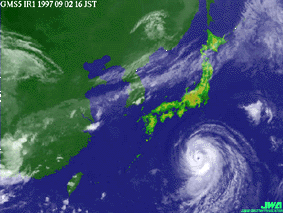ANNUAL CALENDAR September |
|
Typhoons
|
 A lot of typhoons strike Japan between June and October. August and September are particularly prone to these tropical storms. Typhoons develop in the tropical waters north of the equator in the Western Pacific and are defined as tropical storms with gusts of at least 17.2 meters per second (62 kph).
A lot of typhoons strike Japan between June and October. August and September are particularly prone to these tropical storms. Typhoons develop in the tropical waters north of the equator in the Western Pacific and are defined as tropical storms with gusts of at least 17.2 meters per second (62 kph).
Similar storms are called by different names, depending on where they develop. In the Indian Ocean, they are known as cyclones, while in the Atlantic, they're called hurricanes. Hurricanes and cyclones, though, are storms with gusts of at least 32.7 meters per second (118 kph). In the United States, hurricanes are given boys' and girls' names, but in Japan the Meteorological Agency gives typhoons numbers according to the order that they develop, and this is how they are referred to in weather forecasts. Japanese meteorologists classify the typhoons into five levels of size and intensity. TV weather forecasters, therefore, may refer to an approaching storm as "Typhoon No. 8 of large scale and average intensity." An average of 27.8 typhoons form each year, of which 2.8 pass across Japanese land. As they approach Japan, typhoons tend to lose their strength because the waters around the country are cooler than in the tropics. By the time they get close to Hokkaido, most typhoons turn into tropical storms. Typhoons can be powerful enough to decimate large areas--not just in Japan but also in the Philippines and other parts of Southeast and East Asia. There have been a number of large, destructive typhoons in Japanese history; among the biggest was the typhoon that struck Ise Bay in September 1959, claiming 5,000 lives and destroying or damaging 800,000 homes. There hasn't been that much damage in recent years because of improved forecasting techniques, better ways to prevent and escape from disasters, and wider availability of information through the media. The severest typhoon in the past 10 years took the lives of 19 people in September 1991.
Photo: A typhoon approaching Japan, as seen from the Himawari weather satellite. (Japan Meteorological Agency, Japan Weather Association) |
Related Links: Japan Weather Association |
APR | MAY | JUN | JUL | AUG | SEP | OCT | NOV | DEC | JAN | FEB | MAR |
 |